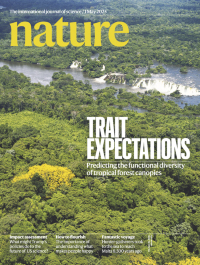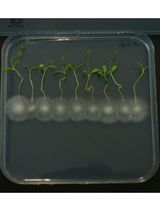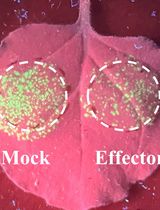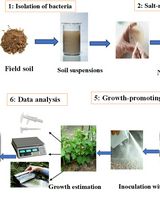- EN - English
- CN - 中文
Virus Isolation and Rice Protoplast Infection
病毒分离与水稻原生质体感染实验
发布: 2025年07月20日第15卷第14期 DOI: 10.21769/BioProtoc.5383 浏览次数: 1481
评审: Tasleem JavaidAnonymous reviewer(s)
Abstract
Rice (Oryza sativa), a staple crop sustaining half of humanity’s caloric intake, is threatened by numerous insect-vector-transmitted diseases, such as rice stripe disease, caused by the rice stripe virus (RSV). Most genetic studies on plant antiviral defense mechanisms rely on natural or artificial infection and transgenic approaches, which require months of plant transformation. Here, we present a streamlined protocol that enables rapid analysis of RSV–host interactions within three days. The method encompasses three key phases: (1) polyethylene glycol (PEG)-based precipitation of RSV virions from infected plant tissues, (2) sequential purification through differential ultracentrifugation with glycerol cushion optimization, and (3) high-efficiency transfection of purified virions into rice protoplasts via PEG-mediated delivery. Viral replication is quantitatively assessed using RT-qPCR targeting viral RNA and immunoblotting with RSV nucleocapsid protein-specific monoclonal antibodies. This approach eliminates dependency on stable transgenic lines, allowing the simultaneous introduction of exogenous plasmids for functional studies. Compared with conventional methods requiring several months for transgenic plant generation, our protocol delivers analyzable results within three days, significantly accelerating the exploration of antiviral mechanisms and resistance gene screening.
Key features
• The protocol purifies virus particles of RSV with strong infection capacity, which can directly infect rice protoplasts when co-transfected with exogenous plasmids for functional studies.
• This transgene-independent approach accelerates antiviral determinant profiling from several months to three days.
Keywords: Rice stripe virus (水稻条纹病毒)Background
Rice stripe virus (RSV), a negative-stranded RNA virus of the genus Tenuivirus (order Bunyavirales), is a devastating pathogen transmitted by the small brown planthopper (Laodelphax striatellus Fallén) that causes severe yield losses in East Asian rice production [1–4]. Unlike other Bunyavirales members, RSV possesses filamentous, non-enveloped virions containing RNA-dependent RNA polymerase (RdRp), essential for replication in both plant hosts and insect vectors [5,6]. Current RSV management primarily relies on pesticide application to control the insect vector, though this approach risks inducing pesticide resistance and environmental contamination. Developing virus-resistant rice cultivars through molecular breeding offers a more sustainable solution but requires a more profound understanding of rice–RSV interactions [7,8].
Conventional plant antiviral studies predominantly employ natural or artificial infection methods, including viruliferous insect feeding, viral RNA/virion inoculation, or Agrobacterium-mediated delivery of viral DNA [9–11]. These approaches necessitate stable transgenic plant lines that require months to develop and validate, significantly delaying resistance gene characterization and antiviral pathway elucidation [12]. While plant protoplast systems bypass the need for stable transformation by enabling transient gene expression, their application in RSV research has been constrained by inefficient virion purification methods [13–15].
Our optimized protocol synergizes PEG-based virion precipitation with glycerol-cushion ultracentrifugation to obtain strong infectious RSV particles with preserved RdRp activity. When combined with PEG-mediated protoplast transfection, this system enables rapid investigation of antiviral mechanisms and high-throughput resistance gene screening within 3 days.
Materials and reagents
Biological materials
1. Seeds of Oryza sativa L. japonica. cv. Nipponbare (preserved by our laboratory)
2. RSV-infected rice materials (preserved by our laboratory)
Reagents
1. Phosphate buffer saline (PBS), 0.5 M, pH 7.5 (Macklin, catalog number: S885311)
2. 2-Mercaptoethanol (Sigma-Aldrich, catalog number: M3148)
3. Triton X-100 (Sigma-Aldrich, catalog number: T8787)
4. Ethylenediaminetetraacetic acid (EDTA) (Sigma-Aldrich, catalog number: E9884)
5. Tirchloromethane/chloroform (Beijing Tong Guang Fine Chemicals Company, catalog number: 112050)
6. Polyethylene glycol (PEG) 6000 (Sigma-Aldrich, catalog number: 528877)
7. PEG 4000 (Sigma-Aldrich, catalog number: 95904)
8. Sodium chloride (NaCl) (Sigma-Aldrich, catalog number: S5886)
9. Potassium chloride (KCl) (Sigma-Aldrich, catalog number: P9541)
10. Calcium chloride dihydrate (CaCl2·2H2O) (Sigma-Aldrich, catalog number: C3306)
11. Potassium hydroxide (KOH) (Sigma-Aldrich, catalog number: 484016)
12. Hydrochloric acid (HCl) (Xilong Scientific, catalog number: SQC5791)
13. Glycerol (Sigma-Aldrich, catalog number: G5516)
14. 2-(N-Morpholino) ethanesulfonic acid, 4-Morpholineethanesulfonic acid (MES) (Sigma-Aldrich, catalog number: M3671)
15. D-Mannitol (Sangon Biotech, catalog number: A600335)
16. Bovine serum albumin (BSA) (Beyotime Biotechnology, catalog number: ST023)
17. Mouse anti-RSV nucleocapsid monoclonal antibody (provided by Dr. Jianxiang Wu from Zhejiang University and Dr. Feng Cui from the Institute of Zoology, Chinese Academy of Sciences)
18. Anti-Mouse IgG(H+L), HRP conjugate (Promega, catalog number: W4021)
19. Rapid Silver Staining kit (Sangon Biotech, catalog number: C500021)
20. MeilunGel precast PAGE gel (10%, Bis-tris, 1.0 mm) (MeilunBio, catalog number: MA0465-1)
21. PageRuler prestained protein ladder (10–180 kDa) (Thermo Scientific, catalog number: 26616)
22. TRIzol reagent (Thermo Scientific, catalog number: 15596018)
23. Diethyl pyrocarbonate (DEPC) (Sigma-Aldrich, catalog number: D5758)
24. RQ1 DNase I (Promega, catalog number: M198A)
25. M-MLV reverse transcriptase (Invitrogen, catalog number: M1701)
26. Recombinant RNasin ribonuclease inhibitor (Promega, catalog number: N2515)
27. 2× M5 HiPer Real-time PCR Super mix with High Rox (SYBR green, with anti-Taq) (Mei5 Biotech, catalog number: MF013-01)
28. Cellulase “ONOZUKA” R-10 (Yalult, catalog number: L0012)
29. Macerozyme R-10 (Yalult, catalog number: L0021)
30. Magnesium chloride (MgCl2) (Sigma-Aldrich, catalog number: M8266)
31. Tris (VWR Life Science, catalog number: 0497)
32. Tween-20 (Xilong Scientific, catalog number: 12900102)
33. Non-fat dry milk powder (Mei5 Biotech, catalog number: MF33421)
34. Sodium hypochlorite solution (Xilong Scientific, catalog number: 17702246)
35. Murashige and Skoog basal medium (Sigma-Aldrich, catalog number: M5519)
Solutions
1. PBS-EDTA solution (see Recipes)
2. W1 solution (see Recipes)
3. W5 solution (see Recipes)
4. PEG-CaCl2 solution (see Recipes)
5. Enzyme solution (see Recipes)
6. MMG solution (see Recipes)
7. Wash buffer (see Recipes)
8. Blocking buffer/antibody dilution buffer (see Recipes)
Recipes
1. PBS-EDTA solution
To prepare EDTA 1 M, pH 8.0 solution, dissolve 14.612 g of EDTA in ultrapure water, adjust pH to 8.0 with KOH, bring the final volume to 50 mL, sterilize using a 0.22 μm filter, and store at 4 °C. Prepare PBS-EDTA solution fresh on the day of use.
| Reagent | Final concentration | Volume (for 50 mL) |
|---|---|---|
| PBS (0.5 M, pH 7.5) | 0.1 M | 10 mL |
| 2-Mercaptoethanol | 0.1% | 50 μL |
| Triton X-100 | 1% | 500 μL |
| EDTA (1 M, pH 8.0) | 0.01 M | 500 μL |
| Ultrapure water | n/a | 38.95 mL |
2. W1 solution
To prepare D-mannitol 1 M solution, dissolve 9.109 g of D-mannitol in 50 mL of ultrapure water and sterilize using a 0.22 μm filter. To prepare MES-KOH 100 mM, pH 5.7 solution, dissolve 0.9762 g of MES in ultrapure water, adjust pH to 5.7 with KOH, bring the final volume to 50 mL, and sterilize with a 0.22 μm filter. To prepare KCl 1 M solution, dissolve 3.728 g of KCl in 50 mL of ultrapure water and sterilize with a 0.22 μm filter. Prepare W1 solution in accordance with the following table, sterilize with a 0.22 μm filter, and store at 4 °C for no more than 3 months.
| Reagent | Final concentration | Volume (for 50 mL) |
|---|---|---|
| D-mannitol (1 M) | 0.5 M | 25 mL |
| MES-KOH (100 mM, pH 5.7) | 4 mM | 2 mL |
| KCl (1 M) | 20 mM | 1 mL |
| Ultrapure water | n/a | 22 mL |
3. W5 solution
To prepare NaCl 5 M solution, dissolve 14.61 g of NaCl in 50 mL of ultrapure water and sterilize with a 0.22 μm filter. To prepare CaCl2 1 M solution, dissolve 7.3505 g of CaCl2·2H2O in 50 mL of ultrapure water and sterilize by 0.22 μm filter. Prepare W5 solution in accordance with the following table, sterilize with a 0.22 μm filter, and store at 4 °C for no more than 3 months.
| Reagent | Final concentration | Volume (for 50 mL) |
|---|---|---|
| NaCl (5 M) | 154 mM | 1.54 mL |
| CaCl2 (1 M) | 125 mM | 6.25 mL |
| KCl (1 M) | 5 mM | 250 μL |
| MES-KOH (100 mM, pH 5.7) | 2 mM | 1 mL |
| Ultrapure water | n/a | 40.96 mL |
4. PEG-CaCl2 solution
Prepare PEG-CaCl2 solution fresh on the day of use.
| Reagent | Final concentration | Volume (for 20 mL) |
|---|---|---|
| D-mannitol (1 M) | 0.2 M | 4 mL |
| CaCl2 (1 M) | 100 mM | 2 mL |
| PEG 4000 | 40% | 8 g |
| Ultrapure water | n/a | bring the final volume to 20 mL |
5. Enzyme solution
Prepare enzyme solution in accordance with the following table and add the reagents in the following sequence. After cellulase and macerozyme are thoroughly mixed and dissolved, incubate the mixture in a 55 °C water bath for 10 min, cool naturally, then add CaCl2 and BSA. Finally, sterilize the solution with a 0.22 μm filter and store at -80 °C for no more than 3 months.
| Reagent | Final concentration | Volume (for 50 mL) |
|---|---|---|
| D-mannitol (1 M) | 0.4 M | 20 mL |
| MES-KOH (100 mM, pH 5.7) | 20 mM | 10 mL |
| KCl (1 M) | 20 mM | 1 mL |
| Cellulase “ONOZUKA” R-10 | 1.5% (w/v) | 0.75 g |
| Macerozyme R-10 | 0.7% (w/v) | 0.35 g |
| CaCl2 (1 M) | 10 mM | 0.5 mL |
| BSA (5% w/v) | 0.1% (w/v) | 1 mL |
| Ultrapure water | n/a | bring the final volume to 50 mL |
6. MMG solution
To prepare MgCl2 1 M solution, dissolve 4.7605 g of MgCl2 in 50 mL of ultrapure water and sterilize with a 0.22 μm filter. Prepare MMG solution in accordance with the following table, sterilize with a 0.22 μm filter, and store at 4 °C for no more than 3 months.
| Reagent | Final concentration | Volume (for 50 mL) |
|---|---|---|
| D-mannitol (1 M) | 0.4 M | 20 mL |
| MgCl2 (1 M) | 15 mM | 0.75 mL |
| MES-KOH (100 mM, pH 5.7) | 4 mM | 2 mL |
| Ultrapure water | n/a | bring the final volume to 50 mL |
7. Wash buffer
To prepare Tris-HCl 1 M, pH 8.0 solution, dissolve 121.14 g of Tris in ultrapure water, adjust pH to 8.0 with HCl, bring the final volume to 1,000 mL, sterilize by autoclaving, and store at room temperature. Prepare wash buffer in accordance with the following table and store at 4 °C for no more than 3 months.
| Reagent | Final concentration | Volume (for 1,000 mL) |
|---|---|---|
| Tris-HCl (1 M, pH 8.0) | 0.2 M | 200 mL |
| NaCl | 1.5 M | 87.75 g |
| Tween-20 | 1‰ | 1 mL |
| Ultrapure water | n/a | bring the final volume to 1,000 mL |
8. Blocking buffer/Antibody dilution buffer
Dissolve 5% (v/v) non-fat dry milk in wash buffer and prepare fresh on the day of use.
Laboratory supplies
1. 10 μL pipette tips (Axygen, catalog number: AXYTF300RS)
2. 200 μL pipette tips (Axygen, catalog number: AXYTF200RS)
3. 1,000 μL pipette tips (Axygen, catalog number: AXYTF1000RS)
4. Sterile syringe filters (Millipore, catalog number: SLGV033RB)
5. Miracloth (Millipore, catalog number: 475855)
6. Sterile 50 mL conical tubes (Corning, catalog number: 430828)
7. Sterile 1.5 mL microtubes (Axygen, catalog number: AXYMCT150CS)
8. 2 mL microtubes, round bottom, snap-cap (Biosharp, catalog number: BS-20-M)
9. 3.5 mL open-top thick-wall polycarbonate tube (Beckman Coulter, catalog number: 349622)
10. Sterile 12-well cell culture plate (NEST Biotechnology, catalog number: 712001)
11. Nitrocellulose blotting membrane (GE Healthcare Life Science, catalog number: 10600003)
12. Sterile cell strainer (40 μm nylon mesh) (ThermoFisher Scientific, catalog number: 22363547)
Equipment
1. Refrigerated ultracentrifuge (Beckman Coulter, model: Optima MAX-XP)
Procedure
文章信息
稿件历史记录
提交日期: May 8, 2025
接收日期: Jun 16, 2025
在线发布日期: Jul 3, 2025
出版日期: Jul 20, 2025
版权信息
© 2025 The Author(s); This is an open access article under the CC BY-NC license (https://creativecommons.org/licenses/by-nc/4.0/).
如何引用
Huang, Y., Yang, Z. and Li, Y. (2025). Virus Isolation and Rice Protoplast Infection. Bio-protocol 15(14): e5383. DOI: 10.21769/BioProtoc.5383.
分类
植物科学 > 植物生理学 > 生物胁迫
植物科学 > 植物免疫 > 宿主-细菌相互作用
微生物学 > 微生物-宿主相互作用 > 病毒
您对这篇实验方法有问题吗?
在此处发布您的问题,我们将邀请本文作者来回答。同时,我们会将您的问题发布到Bio-protocol Exchange,以便寻求社区成员的帮助。
提问指南
+ 问题描述
写下详细的问题描述,包括所有有助于他人回答您问题的信息(例如实验过程、条件和相关图像等)。
Share
Bluesky
X
Copy link












